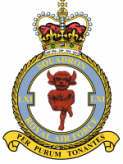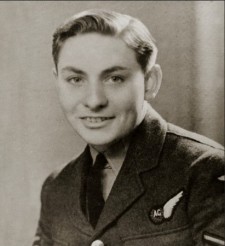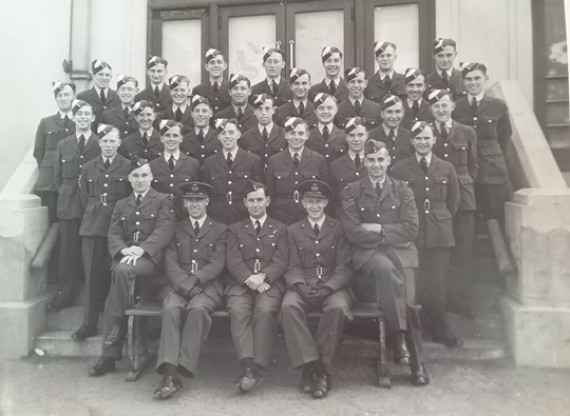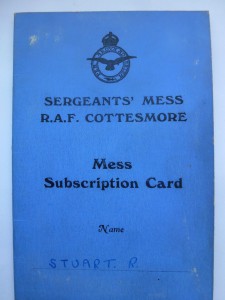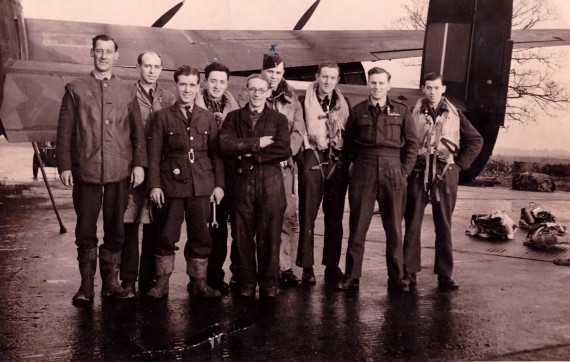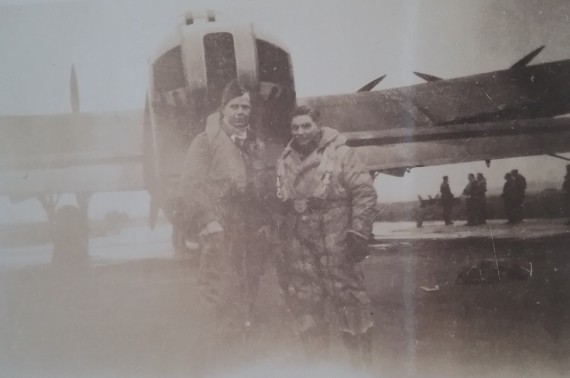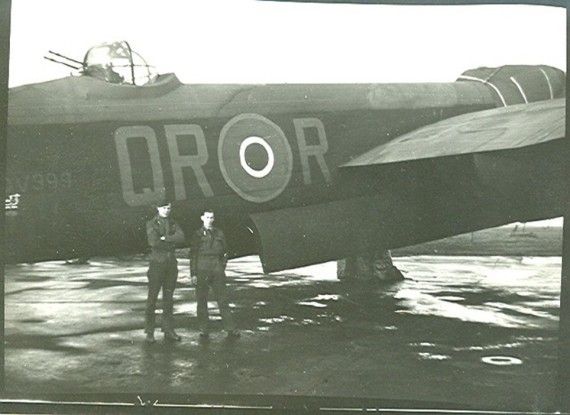Sergeant Richard Stuart
Richard “Dick” Stuart grew up with his brother and three sisters on a small dairy farm in the Cheshire village of Astbury. As a young man, he played soccer for Congleton Town FC and was a popular figure with the local ladies.
In June 1942, he answered the call of duty and joined the RAFVR. His training took him across the Atlantic to No 3 B&G School at MacDonald, Manitoba, set in the Canadian prairies West of Winnipeg. He trained there as an air gunner over the winter of ‘42/43, before embarking on the RMS Queen Elizabeth at Halifax, Nova Scotia, on 28th March for the voyage back to war-torn Europe.
He was sent to RAF Cottesmore on 20th April for the next stage of his training. “I got crewed up today”, he wrote to his brother on 24th April. “An Australian PO pilot has asked me to join him. I wanted an Aussie for a pilot, they are good guys. This one, George Harvey from Queensland, seems no exception.” Dick was correct in his assessment. George Harvey qualified as a pilot of “above average” ability, and subsequent events showed him to be a responsible and capable leader. George’s other crew picks were “Reg” Carver, navigator, from Crofton Park in South London, “Harry” Sheppard, bomb aimer, from the Isle of Sheppey and Noel “Ginger” Meehan, wireless operator, an Irishman.
The five man crew trained in Wellingtons, moving to RAF Saltby on 17th May, before transferring on July 16th to No 1654 Conversion Unit at Wigsley to train on Lancasters. Here, they were joined by Stuart “Ken” Kennedy, flight engineer, from Cowdenbeath in Scotland and Don “Tommy” Thomas RCAF, mid-upper gunner, from Merriton, Ontario. The seven men completed their training and were posted to 61 Squadron at Syerston on 19th August 1943.
Dick's Crew Mates - Back Row from Right:- "Reg" Carver (Nav), George Harvey (Captain), Noel "Ginger" Meehan (W/Op), Don "Tommy" Thomas (M/U Gunner) and Stuart "Ken" Kennedy (F/Eng). The four ground crew are not identified, but are thought to include “Oscar” and “Geordie”. Photo from George Harvey’s family
The first impression they created at 61 Squadron was less than glorious. On the 25th they were sent out for a combined bombing, gunnery and cross-country exercise, where they were required to drop smoke flares into the North Sea and then bomb the smoke. Unfortunately, both their smoke flares sank, leaving them with nothing to aim at. Then, Harry the bomb aimer suggested bombing a shipwreck they had passed on the way out, so they found the rusting hulk and successfully bombed it. To give the gunners a work-out, they made a few strafing passes before flying back to Syerston, feeling well pleased with their contribution to the war effort. Their bubble was abruptly burst when a car screeched to a halt under the nose of their Lancaster and the adjutant stormed out. “…if your lot are the stupid clots who shot up that boat, you’re for the high jump.”
A few minutes later they were in front of an angry Wing Commander Penman, fresh from a phone call with the Navy, “screaming bloody murder” because a salvage crew had been on the boat. George Harvey owned up in detail and the crew got away with writing letters of apology to their victims, amidst mutterings about the many failings of “sprog crews”.
Maybe as payback for this incident, they subsequently had a sprog crew prank played on them. Someone told them they would be getting their own aircraft, which was very unusual this early in their career. They diligently set to work on the newly delivered Lancaster, aligning and testing the guns, cleaning the aircraft, polishing the Perspex and test flying to check that everything was just right. The aircraft, “N-Nan”, went on to an illustrious career, but Dick and the crew never flew in her again.
Things didn’t improve on the 23rd when George, the captain, went off on a “second dickie” familiarisation flight. The crew waited up to count the returning bombers in, but to their dismay George was not amongst them. It turned out that his aircraft had returned early with engine failure and George had retired safely to bed. George finally completed his second dickie trip to Nurnberg on the 27th and the crew were ready for their first op.
They had a relatively gentle introduction to operational flying, with a short trip to Monchengladbach on 30th August. The second op on 31st August was a different story, though, with the “Big City” as the target. Dick confided in his diary that he “wasn’t exactly happy” at the prospect. Sure enough, they got a taste of real war, with both Dick and Tommy opening fire on night fighters that approached them. Dick’s diary recorded that “It didn’t turn out so bad”, and to make things better the station allowed them transport into Nottingham where he met a “real swell girl”.
Over the next three months, under George Harvey’s skilful leadership, Dick and his crewmates steadily built up their experience. They were back to Berlin on 3rd September, then Mannheim on the 5th, which was the first operation in their own aircraft; JB116 R-Roger. On the 6th they went to Munich and had another encounter with a JU88. Tommy got in a good burst and claimed it in the combat report as damaged, possibly destroyed. Dick’s diary stated “Had it pretty tough over Munich and I think Tommy shot one down”.
The next trip was to Hannover on 22nd September, with Tommy firing a burst at a fighter on the return journey. They were back to Hannover on the 27th, with Dick’s verdict being “it wasn’t too bad”. October 1st took them on an uneventful trip to Hagen, then Kassel on the 3rd, again with no fighters or flak, followed by Frankfurt on the 4th.
October 7th was a raid on Stuttgart, which turned out to be quite eventful. Tommy’s account reports that a small German air raid took place, which fired up the British air defences just as the RAF bomber stream was on its way South. Their Lancaster was “intercepted” by a Beaufighter and a Mexican stand-off ensued, in which neither aircraft dared make a move in case it spooked the other into opening fire. Tommy said he finally took a torch and flashed a short message in morse code which politely translated as “go away”. The Beaufighter got the message and slowly dropped back out of sight. The return from Stuttgart was also dramatic due to widespread fog over the bomber bases. Dick’s crew was one of many diverted to Hurn near Bournemouth, resulting in chaos over the diversion airfield and unfortunately some crashes.
On 18th October, Dick’s birthday, they were back to Hannover again, entrusted for the first time with a second dickie to gain experience with the now battle-hardened crew.
20th October was a terrible trip to Leipzig through storm fronts, heavy icing and a near impossibility of locating the target in the dreadful weather, finishing up with an emergency landing at Foulsham.
On 22nd October the target was Kassel again and they had an encounter with a searchlight. George’s diary reports that they had to dive out of it five times before losing it for good. Weather was poor, with a lot of icing, and they were diverted to Swinderby on the way back.
Dick and his crew got some well-earned leave, but arrived back to find the squadron was moving from the well-appointed pre-war base at Syerston to somewhat more primitive facilities at Skellingthorpe.
Their first op from the new base was Berlin on 18th November and Dick suffered a drama on this trip. From his mid-upper vantage point, Tommy noticed that Dick’s turret had stopped moving. George sent the flight engineer and second dickie pilot back to investigate, finding Dick slumped over his guns and the turret hydraulics frozen. It turned out Dick had been air sick into his oxygen mask, which had frozen and blocked his oxygen supply. Fortunately his crewmates brought him round quickly.
They were back to Berlin on the 22nd November and again to the Big City on the 26th where they were coned by searchlights for about a minute on the run in to the target. Tommy described George’s brutal diving manoeuvres, violating the Lanc’s never-exceed speed to escape the cone.
A Lancaster next to them was hit and trailed flames. Dick saw one man bail out OK. The next man’s chute burnt away because he pulled it too early, and a third man was wrapped round the tail and dragged to his death behind the burning aircraft. Dick told Tommy, but kept what he had seen from the rest of the crew.
It was on the return from this op that luck began to turn against them. It started with near farce, when Reg the navigator had to make an emergency trip to the elsan toilet in the rear fuselage. The Lancaster’s equipment did not include toilet paper, so Reg grabbed a handful of maps which he didn’t need any more as they were on the way home. Then came a radio message saying Skellingthorpe was fogged in and their diversion airfield was RAF Catfoss, with coordinates given. To his horror, Reg realised that the relevant map was now in the elsan toilet and reluctantly broke the news to the crew. Fortunately, Ginger the wireless operator had been there before and was able to save the day, so they landed at a bleak and inhospitable training base inland from Bridlington in Yorkshire.
The fog persisted for a couple of days before clearing enough to attempt a take-off. The squadron climbed into their aircraft, but then went on standby as an aircraft further up the line had flat batteries. While these were being replaced, routine Beaufighter training flights were in progress. Then one of the Beaufighters developed engine trouble, attempted an emergency landing, but headed directly for R-Roger. Some of the crew got out before the Beaufighter’s undercarriage straddled R-Roger’s mid upper turret and broke the Lancaster’s back. Miraculously, the worst injury was concussion. George had to be rescued from the cockpit by a ladder, and in his diary he reports it “broke his heart” to see their 100% reliable Roger lying wrecked. It was subsequently repaired, re-issued to 9 Squadron and lost on an operation to St Leu d’Esserent on 7th July 1944.
With Roger gone, their next trip, to Leipzig on 3rd December, was in “S-Sugar”, a war-weary Lancaster with yellowing Perspex and engines that emitted copious streams of sparks. In the approach to Leipzig a flak shell exploded under a wing and spun them round. Another flak shell then burst where they would have been if they had continued flying straight. On their way out of the target area they were attacked by a night fighter which was engaged by Tommy in the mid-upper turret. Dick was unable to return fire, because a flak splinter had severed the hydraulic line to the rear turret. However, the fighter was scared off by Don’s onslaught and they got home safely.
It appeared that things were looking up when a new Lancaster, DV399, was delivered to the squadron. Because of the crew’s experience and seniority, George was able to secure DV399 as the new “R-Roger” and they set about familiarising with the new aircraft. On 11th December, they went out on a practice bombing exercise, dropping their bombs but getting no credit because they didn’t explode. It turned out that poor Harry, the bomb aimer, had forgotten to arm them. Sadly, Harry appeared to take the experience badly, because the following day he got on his bike to go back to his lodgings, rode in front of a car and was knocked into a ditch. According to George’s diary, he was not badly hurt, but the car went in on top of him and pinned Harry face down. The man who had survived nearly 20 ops over Nazi Germany ended his life drowned in a Lincolnshire ditch. George once again showed his strength of character by insisting on personally breaking the news to Harry’s wife, who expressed disbelief at what she was told.
It was Berlin again on 23rd December. Dick wrote in a letter to his family that his crew now held the squadron record for trips to the Big City.
Christmas 1943 was Dick’s last, but a very happy one. He had always been popular with the ladies and a steady stream of girlfriends had come and gone. But then he had met Doreen, who lived in Davies Road, West Bridgford; a suburb of Nottingham. Dick’s letters told the tale that Doreen was more than just another girlfriend. He told his brother that he “had found himself courting” and confided to his oldest sister that he was thinking of marrying. A letter to his parents said he had been invited to spend Christmas at Davies Road and he duly turned up at Doreen’s house on Christmas Eve. The next day the whole family enjoyed Christmas dinner at a posh hotel in Nottingham. He stayed with Doreen for Boxing Day and the 27th, before finally travelling back to Skellingthorpe on the 28th. His diary repeatedly declared his love for Doreen and how wonderful it had been to stay with her and her family for that memorable Christmas. Wedding bells appeared to be in the air for the New Year.
There were no ops on the 28th. Instead Bomber Harris had planned a big effort on Berlin for the 29th, the symbolic third anniversary of the worst night of the London blitz. By now, Dick and his crew were hardened veterans. George had been promoted to F/Lt and was standing in as acting Flight Leader. Tommy had been promoted to P/O. The experienced crew was an obvious selection for wind finding duties and a captain of George’s calibre was always eager to take on more responsibility. On 29th December, with Kenneth Prouten from Lake, Isle of Wight, serving as stand-in bomb aimer, they took off from Skellingthorpe at 1622, about 20 mins ahead of the rest of the squadron, setting off to make their wind observations and radio back the data to aid the bomber stream following behind them.
They were South of Magdeburg when they sent their second radio transmission. Maybe it was this that gave them away, but the Germans knew that they were there. Without warning, they were coned by searchlights and a flak barrage opened up around them. They took a hit directly under the belly of the aircraft and Tommy felt flames coming up through the floor beneath his mid-upper turret. He had to get out in a hurry, but his oxygen mask was tangled inside the turret and he tore it off to escape the flames. He got down inside the fuselage and saw Dick, outside the rear turret, still connected to the intercom and pointing to the door. Tommy tried to open the door but was already suffering from oxygen starvation, as well as his burns, and collapsed unconscious on the floor. The next thing he knew was someone shouting in his ear. It was Dick, who had got the door open and stirred Tommy back to consciousness. Tommy dragged himself out and fell rapidly with a badly burnt parachute. On his way down he saw another parachute, which turned out to be “Ginger” Meehan, who did not survive, then an explosion from the aircraft. Dick and his remaining crewmates went down with DV399, which crashed between the small towns of Augsdorf and Heiligenthal in Lower Saxony.
Tommy landed in a freshly ploughed field which broke his fall enough to keep him alive, although injured by the impact. A German soldier saved his life by stopping a group of civilians from kicking him to death. He ended up in Stalag Luft 3, although he does not make any mention of the great escape, and wrote a detailed account of the crew’s activities after the war. He said he could not understand why Dick had not followed him out of the aircraft and assumed he must have stayed on board to help the rest of the crew. Don “Tommy” Thomas died in 1993.
Dick and his crewmates now rest in the Commonwealth War cemetery in Berlin.
References:
Ref 1.61 Squadron Operations Record Book and combat reports
Ref 2.Letters written by Sgt Dick Stuart to family members
Ref 3.The diary of Sgt Dick Stuart
Ref 4.“The Airborne Years” by J.A. Campbell
Ref 5.The diary of F/Lt George Harvey (property of George’s family)
Ref 6.The memoirs of P/O Don Thomas (property of the Thomas family)


